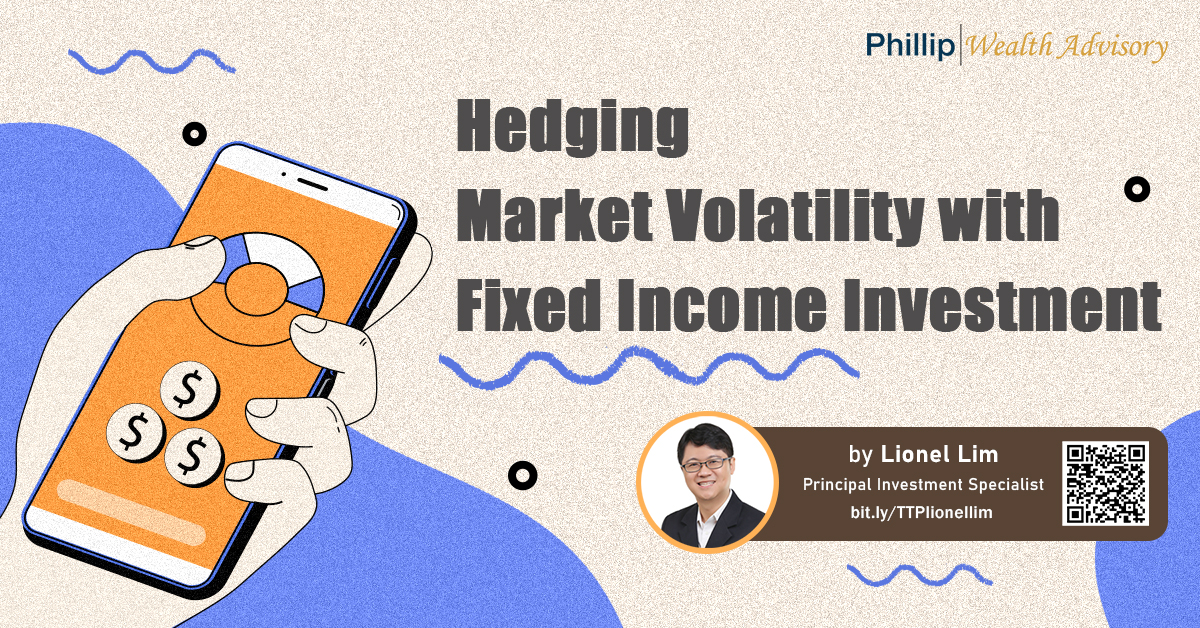Hedging Market Volatility with Fixed Income Investment September 27, 2024

How I got into Selling Corporate Bonds
When I first entered the stock broking industry, I had never given any serious thought to fixed income investments. My impression was that fixed income investments generally generated lower returns compared to equities and equity funds.
However, approximately 15 years ago, a client asked me about corporate bonds and that’s where my journey with fixed income investments began. Over the next five years, I conducted extensive research and read countless articles on fixed income, and gained a solid understanding. Overtime, with practice, I developed a strong expertise in the bond market.
One of the biggest turning points that made me appreciate bonds was the volatility I witnessed in corporate bonds during the COVID-19 pandemic. There was a major sell off in the global equity markets, and a client of mine became very anxious and contacted me frequently. Fortunately, his corporate bond portfolio was able to help hedge against the market volatility. The volatility of bonds was lower compared to equities, allowing him to sleep better at night.
The credit goes to the client. He was prudent with his investments and did his due diligence before investing in corporate bonds, which eventually paid off. None of the bonds he held defaulted. During this period, while many listed companies cut their dividend payment to investors, the coupon payment for bonds remained consistent.
Hedging market volatility with fixed income investments can be an effective strategy to preserve capital and generate stable returns. Here are some key points and strategies to consider:
Key Points
1. Fixed Income Basics:
- Definition: Fixed income investments typically involve loans made to corporations or governments, which pay interest over time and return the principal at maturity.
- Types: Government bonds, Statutory board bonds, Corporate bonds, and Perpetual securities.
2. Market Volatility:
- Impact: Equity markets can experience significant price fluctuations due to economic, political, or global events.
- Goal of Hedging: To reduce the overall risk of a portfolio by balancing more volatile assets (like stocks) with more stable ones (like fixed income).
Strategies for Hedging with Fixed Income
1. Diversification:
- Spread investments across various types of fixed income securities (e.g. government, corporate, and municipal bonds)
- Diversify by credit quality, maturity dates, and geographical locations
2. Laddering:
- Invest in bonds with staggered maturity dates
- This approach ensures that a portion of the portfolio matures regularly, providing liquidity and reducing interest rate risk
3. High-Quality Bonds:
- Invest in high credit quality bonds, such as U.S. Treasuries, Singapore Government Bonds, Temasek/GIC backed corporate bonds or AAA-rated corporate bonds, which are less likely to default
- These are generally safer during times of economic uncertainty
4. Interest Rate Considerations:
- Be mindful of the interest rate environment. When rates are expected to rise, shorter-duration bonds are less sensitive to rate increases
- Conversely, longer-duration bonds may perform better when rates are expected to fall
5. Tax Considerations:
- Interest Income is taxable for corporations in Singapore. For individuals, it’s not taxable (Please check with your tax consultant if ever in doubt)
6. Bond Funds:
- Bond funds offer diversification within fixed income and can be more liquid compared to individual bonds
- They provide access to professional management and a wide range of bond markets
- A small amount of money as little as S$1000 can be invested into Bond funds
Considerations
1. Credit Risk:
- The risk that a bond issuer may default. Mitigate by investing in high-quality bonds and diversifying
2. Interest Rate Risk:
- The risk that changes in interest rates will affect bond prices. Manage by laddering and using short-duration bonds
3. Liquidity Risk:
- The risk of not being able to sell a bond quickly without affecting its price. Fixed income funds can offer more liquidity
4. Reinvestment Risk:
- The risk of reinvesting proceeds at lower rates. Staggering maturities helps mitigate this risk
Conclusion
Hedging market volatility with fixed income involves careful selection and management of various types of bonds to create a balanced and diversified portfolio. By understanding and applying these strategies, investors can achieve more stable returns and protect their capital from market volatility.
Contributor:

Lionel Lim
Principal Investment Specialist
Phillip Securities Pte Ltd (A member of PhillipCapital)
https://bit.ly/TTPlionellim
Disclaimer
These commentaries are intended for general circulation. It does not have regard to the specific investment objectives, financial situation and particular needs of any person who may receive this document. Accordingly, no warranty whatsoever is given and no liability whatsoever is accepted for any loss arising whether directly or indirectly as a result of any person acting based on this information. Opinions expressed in these commentaries are subject to change without notice. Investments are subject to investment risks including the possible loss of the principal amount invested. The value of the units and the income from them may fall as well as rise. Past performance figures as well as any projection or forecast used in these commentaries are not necessarily indicative of future or likely performance. Phillip Securities Pte Ltd (PSPL), its directors, connected persons or employees may from time to time have an interest in the financial instruments mentioned in these commentaries. Investors may wish to seek advice from a financial adviser before investing. In the event that investors choose not to seek advice from a financial adviser, they should consider whether the investment is suitable for them.
The information contained in these commentaries has been obtained from public sources which PSPL has no reason to believe are unreliable and any analysis, forecasts, projections, expectations and opinions (collectively the “Research”) contained in these commentaries are based on such information and are expressions of belief only. PSPL has not verified this information and no representation or warranty, express or implied, is made that such information or Research is accurate, complete or verified or should be relied upon as such. Any such information or Research contained in these commentaries are subject to change, and PSPL shall not have any responsibility to maintain the information or Research made available or to supply any corrections, updates or releases in connection therewith. In no event will PSPL be liable for any special, indirect, incidental or consequential damages which may be incurred from the use of the information or Research made available, even if it has been advised of the possibility of such damages. The companies and their employees mentioned in these commentaries cannot be held liable for any errors, inaccuracies and/or omissions howsoever caused. Any opinion or advice herein is made on a general basis and is subject to change without notice. The information provided in these commentaries may contain optimistic statements regarding future events or future financial performance of countries, markets or companies. You must make your own financial assessment of the relevance, accuracy and adequacy of the information provided in these commentaries.
Views and any strategies described in these commentaries may not be suitable for all investors. Opinions expressed herein may differ from the opinions expressed by other units of PSPL or its connected persons and associates. Any reference to or discussion of investment products or commodities in these commentaries is purely for illustrative purposes only and must not be construed as a recommendation, an offer or solicitation for the subscription, purchase or sale of the investment products or commodities mentioned.
About the author
Lionel Lim
Principal Investment Specialist
Lionel Lim joined Phillip Securities as a Trading Representative in 2005, driven by a passion for investments. Over the years, Lionel has gained extensive experience in servicing clients across various investment products, including stocks, corporate bonds, unit trusts, CFDs, and ETFs. Lionel enjoys engaging with clients and exchanging investment ideas. In addition, Lionel provides clients with daily updates through research reports and market news. Prior to joining PhillipCapital, Lionel also gained experience in auditing and banking.

 Oracle Corporation Raises FY27 Revenue Guidance by $4 Billion Amid Strong Cloud Growth
Oracle Corporation Raises FY27 Revenue Guidance by $4 Billion Amid Strong Cloud Growth  Adobe Inc Delivers Solid FY25 Results as Semrush Acquisition Strengthens Marketing Portfolio
Adobe Inc Delivers Solid FY25 Results as Semrush Acquisition Strengthens Marketing Portfolio  Magnificent 7 Tech Stocks Post Mixed Performance in November 2025
Magnificent 7 Tech Stocks Post Mixed Performance in November 2025  Sembcorp Industries Enters Australian Energy Market via S$4.8bn Alinta Deal
Sembcorp Industries Enters Australian Energy Market via S$4.8bn Alinta Deal 




